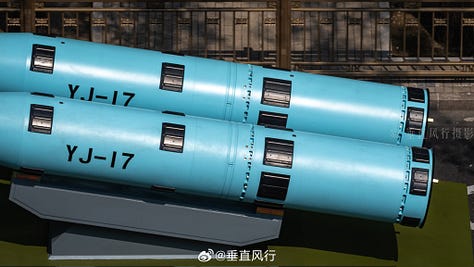China's Diverse Array Of Newly Unveiled Anti-Ship Munitions Is Impressive But Expensive And Possibly An Inefficient Resource Allocation
🇨🇳
Note: The following text was originally posted on my X/Twitter account.
China's recently unveiled YJ-17 and YJ-20 anti-ship missiles, which are a boost-glide vehicle/hypersonic glide vehicle (BGV/HGV) and anti-ship ballistic missile design, respectively, utilize very different solid-propellant rocket boosters. The booster of the YJ-17 is a particularly interesting design. In both cases, it remains to be seen whether China will seek to make the most of its research and development (R&D) expenditures to employ these booster designs toward some other purpose. Observers should be mindful that the Chinese R&D and procurement processes are likely to be shaped by any number of factors that lead to inefficiencies, including perhaps some inefficiencies that are idiosyncratic to China and its particular political economy. Observers have no reason to assume that only non-Chinese militaries, including the American military, regularly encounter major inefficiencies when it comes to allocating finite resources toward both R&D and procurement.



It is possible that the YJ-17 and YJ-20—as well as the conceptually related but otherwise very distinct recently unveiled YJ-19—are the products of different parts of China's sprawling and primarily state-owned military industry. As a result, it is possible that these designs do not incorporate any common components or build upon Beijing's aggregated investments in what are, to at least some extent, likely to amount to rival designs and competitors for a large but nevertheless finite amount of procurement Yuan ¥ that can be allocated toward anti-ship munitions in a given year. While each of the new anti-ship munitions that were unveiled at the recent Chinese military parade is optimized for a particular role and collectively offer the Chinese military considerable synergies, even China must adeptly allocate its finite resources, and there is a case to be made that more prudent decision-makers may have forgone allocating the immense resources required to both develop and deploy such a large number of anti-ship munitions that are to some extent or another practical substitutes for one another.

